-
What is the axis of symmetry called??The principal axis
-
What is the principal focus??A point on the axis which is the same distance from the optical centre as the focal length. This is where light rays travelling parallel to the principal axis prior to refraction converge.
-
Define focal length??
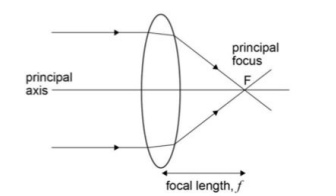 The distance between the centre of the lens and the principle focus
The distance between the centre of the lens and the principle focus -
What does 'u' represent in lens diagrams and equations?The distance between the object and the centre of the lens u is always positive
-
What does 'v' represent in lens diagrams and equations??The distance between the image and the centre of the lens v is positive for real images and negative for virtual images
-
Draw the ray diagram for an object that is a distance beyond 2F and describe the image appearance
 The image is real and inverted but smaller than the object, diminished
The image is real and inverted but smaller than the object, diminished -
Draw the ray diagram for an object that is really close to the lens and describe the image's appearance
 The image is virtual and upright and bigger than the object , magnified
The image is virtual and upright and bigger than the object , magnified -
Draw the ray diagram of an object that is between F and 2F to the lens and describe the image's appearance
 The image is real and inverted but bigger than the object, magnified
The image is real and inverted but bigger than the object, magnified -
Draw the ray diagram for an object that is at 2f and describe the image's appearance
 The image is real and invertedbut the same size
The image is real and invertedbut the same size -
What does normal adjustment in a telescope look like??
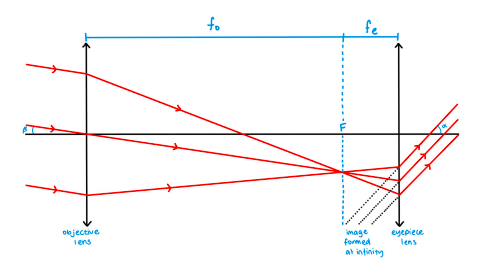
-
What is the formula for angular magnification in normal adjustment
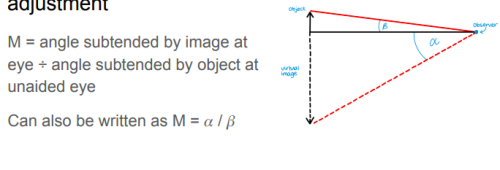
-
What is the equation that relates M to the focal length for the objective and eyepiece lenses?M = angular magnification M = f0/fe can only be used if both alpha and beta are less than 10 degreed
-
How does an astronomical refracting telescope work?There are two converging lenses, the objective lens and the eyepiecce lens The role of the objective lens is collect light and create a real image of a distant object This image is then magnified by the eyepiece lens, which produces a virtual image (formed at infinity to reduce eye strain when looking between the object and the telescope image)
-
How does a cassegrain telescope work?There is a concave primary mirror with a long focal length and a small convex secondary mirror in the centre. The light is collected by the primary mirror and focused onto the secondary mirror, which then reflects it onto an eyepiece lens.
-
What does the Cassegrain configuration look like?
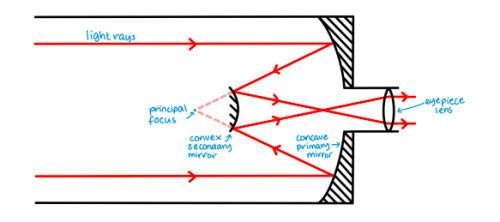
-
What is chromatic aberration??When a lens refracts different colours of light by different amounts as they have different wavelengths This causes the image for each colour to form in a slihtly different position, causing coloured fringes around the image
-
What is spherical aberration??
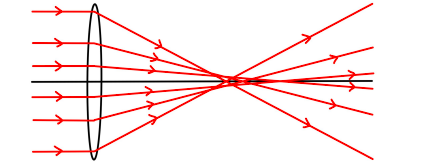 When light is focused in different places due to the curvature of a lens or mirrror, causing image blurring. This can be resolved in reflecting telescopes by using a parabolic mirror.
When light is focused in different places due to the curvature of a lens or mirrror, causing image blurring. This can be resolved in reflecting telescopes by using a parabolic mirror. -
Describe a solution to chromatic and spherical aberration in lenses..
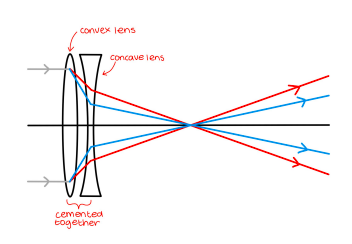 Using an achromatic doublet brings all rays of light into focus in the same position by using a convex lens of different types of glass cemented together.
Using an achromatic doublet brings all rays of light into focus in the same position by using a convex lens of different types of glass cemented together. -
State 3 advantages of reflecrting telescopesThere is very little chromatic aberration - only in the eyepiece lens but this cab be resolved using an achromatic doublet Simpler to increase the size of the objective lens since mirrors can be supported from ehin and are bigger than lenses Using parabolic mirrors stops spherical aberration
-
What happens when you increase the size of the objective lens/mirror??Increasing the diameter of the objective lens means tyou can observe fainter objects. This is because collecting/light gathering power is (pi x(objective diameter)^2)/4
-
Define the Rayleigh Criterion.
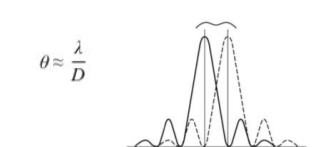 'Two objects will just be resolved is the centre of the diffraction pattern coincides with the minimum of the other'
'Two objects will just be resolved is the centre of the diffraction pattern coincides with the minimum of the other' -
Explain the structure, positioning and uses of a single dish radio telescope..Structure: large parabolic dish that focuses radiation onto a receiver Positioning: can be ground-based but must be in isolated locations Uses: observing things such as galaxis, stars and black holes
-
Why do radio telescopes need to be larger than optical telescopes??
 Since radio waves have a much larger wavelength than visible light, in order to achieve the same resolving power as an optical telescope The objective diameter must be larger in accordance with...
Since radio waves have a much larger wavelength than visible light, in order to achieve the same resolving power as an optical telescope The objective diameter must be larger in accordance with... -
Explain the structure, positioning and uses of an infared telescope.Structure: large concave mirror focusing light onto a detector. Must be cooled withcryogenic fluids to avoid interference Positioning: Must be in space as infared light is blocked by the atmosphere Uses: observing cooler regions in space (from a few tens to 100K)
-
Explain the structure, positioning and uses of an ultraviolet telescope.Structure : Cassegrain configuration that focuses radiation onto solid state drives Positioning : must be in space as ultraviolet light is blocked by the ozone layer Uses: observing the interstellar medium and star formation regions
-
Explain the structure, positioning and uses of an x-ray telescopeStructure: combination of hyperbolic and parabolic mirrors to focus radiation onto a CCD Positioning: Must be in space as x-rays are blocked by the atmosphere Uses: observing high-energy events and areas such as active galaxies, black holes and neutron stars
-
Explain the structure, positioning and uses of a gamma telescopeStructure: no mirrors, radiation passes through a detector made of layers of pixels Positioning: must be in space as gamma rays are blocked by the atmosphere Uses: observing gamma ray bursts, quasars, black holes and solar flares
-
Compare the quantam efficiency of a CCD to the eye.Quantam efficiency: the percentage of incident photons that liberate an electron in the photoelectric effect This can be upwards of 80% for a CCS, compared to 4-5% for the human eye
-
Compare the resolution of a CCD to the eye.CCds have a spatial resolution of 10 micrometres, the minimum resolvable distance for the human eye is around 100 micrometers so CCDs are better for capturing fine detail Spatial resolution is how far apart 2 objects need to be distinguish them
-
Compare the convenience of a CCD to the eye.The CCD is more convenient for accessing data remotely (like retrieving data from space telescopes such as Hubble). It easier to analyse CCD data on computers, and CCDs have a wider spectral range, allowing them to perceive wavelengths that connot be detected by the human eye. That being said, looking down a telescope is not an inconvenient task.

